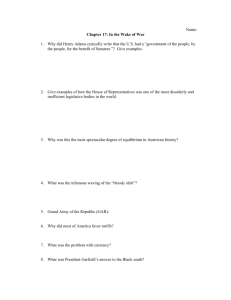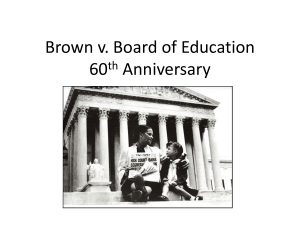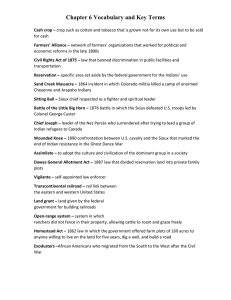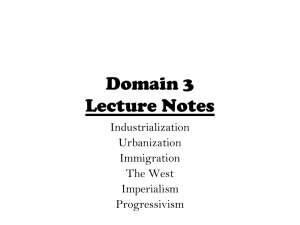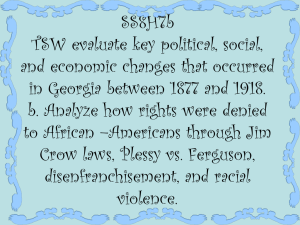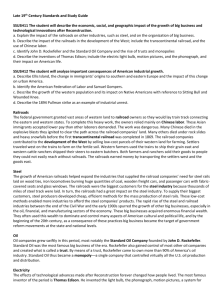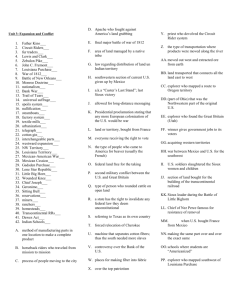Part III Industrialization , Reform, & Imperialism
advertisement
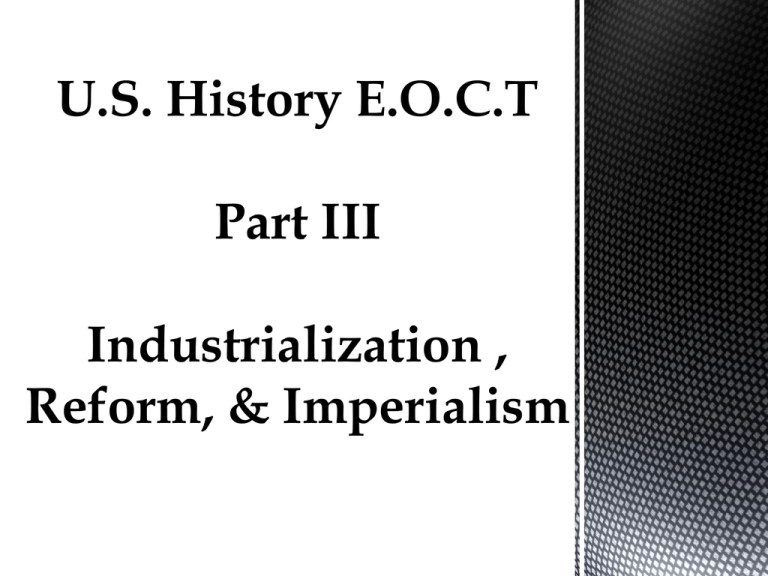
U.S. History E.O.C.T Part III Industrialization , Reform, & Imperialism Impact of growth of business and technological change after the Civil War Consequences of industrialization Reform movements that occurred during the Progressive Era U.S role in world politics at the turn of the 20th century. After Reconstruction, railroad companies and the steel and oil industries expanded and major inventions changed how people lived. The federal government granted vast areas of western land to railroad owners so they would lay train track connecting the eastern and western states. To complete this heavy work, the owners relied mainly on Chinese labor. First transcontinental railroad was completed in 1869. The railroads were the biggest customers for the steel industry because thousands of miles of steel track were laid. In turn, the railroads had a great impact on the steel industry. Oil companies grew swiftly in this period, most notably the founded by John D. Rockefeller. Standard Oil was the most famous big business of the era. Rockefeller also gained control of most other oil companies and created what is called a trust. By means of a trust, Rockefeller came to own more than 90% of America’s oil industry. Standard Oil thus became a monopoly––a single company that controlled virtually all the U.S. oil production and distribution. Which industry did John D. Rockefeller monopolize during the late 1800s? A. the oil industry B. the steel industry C. the railroad industry D. the meatpacking industry Which industry did John D. Rockefeller monopolize during the late 1800s? A. the oil industry B. the steel industry C. the railroad industry D. the meatpacking industry The effects of technological advances made after Reconstruction forever changed how people lived. The most famous inventor of this period is Thomas Edison. He invented the electric light bulb, the phonograph, motion pictures, as system for distributing electrical power. As eastern regions of the United States became more industrialized after the Civil War, people seeking rural livelihoods moved farther and farther west. In turn, Native Americans had to compete with these newcomers for land. For example, the Sioux signed a treaty with the U.S. government promising “no white person or persons shall be permitted to settle upon or occupy” Sioux territory in the Dakotas. When gold was discovered there, the government tried to buy the land from the Sioux, who refused to sell it. The Sioux leader, Sitting Bull, then fought U.S. Army troops, led his people to a brief exile in Canada, and finally agreed to settle on a reservation. About 10 years later, Sitting Bull’s people became associated with a Sioux religious movement. Government officials ordered Sitting Bull’s arrest. He died in a brief gun battle. After Sitting Bull died, several hundred of his people fled to an area of South Dakota called Wounded Knee. Battle at Wounded Knee U.S. soldiers went there to confiscate weapons from the Sioux. A gun was fired––nobody knows by whom––and U.S soldiers then opened machine- gun fire, killing more than 300 Sioux. This ended the Native Americans’ long conflict against Americans settling Native American lands. In the decades after the Civil War, more and more Europeans immigrated to America. They differed from earlier immigrant groups who mostly came from northern and western Europe, were typically Protestant, spoke English, and arrived with the government’s welcome. In contrast, many of the new immigrants came from eastern and southern Europe, often were Jewish or Catholic, and usually spoke no English. The U.S. government welcomed the wealthy, but forced poorer people to pass health and welfare tests at government reception centers such as the Ellis Island Immigrant Station located in New York Harbor. Labor unions banded together for even more power to change the ways employers ran their businesses. The American Federation of Labor, or AFL, was led by Samuel Gompers. He was president of the AFL from 1886 to 1894 and from 1895 to his death in 1924. His goal was to use strikes (work stoppages) to convince employers to give workers shorter work days, better working conditions, higher wages, and greater control over how they carried out their workplace responsibilities. The Pullman railcar factory near Chicago fired almost half of its workforce. Violence erupted when employers sought to fire some worker and to lower wages of those still employed. The Pullman company responded by hiring new workers, but these workers were attacked by strikers when they attempted to go to work. President Cleveland sent the U.S. Army to restore peace. Both big business and the US government feared labor unions were a menace to America’s capitalist economy. Many reforms came about after journalists investigated and exposed political corruption, child labor, slum conditions, and other social issues. These journalists were called muckrakers, and famous among them were Upton Sinclair and Ida Tarbell. In his novel The Jungle, Sinclair told the story of European immigrants working in Chicago’s meatpacking industry. The book exposed the poor labor practices and unsanitary conditions that produced contaminated food. Congress was pressured to pass laws to regulate the meatpacking industry and to require meat packers to produce food that was safe to consume. In a series of magazine articles, Tarbell exposed political corruption in New York, Chicago, and other cities, and criticized Standard Oil Company’s unfair business practices. Her findings angered the public and contributed to the government’s decision to break up the Standard Oil Trust. Jane Addams brought a British idea, the settlement house, to the United States, when she established Hull House in Chicago. Hull House was a social service agency that provided trained workers to help recent immigrants and working-class citizens learn about home economics, basic medical care, the English language, legal rights, and other topics important to lowincome urban residents. Progressive election reforms helped to increase ordinary citizens’ direct control of government in 3 ways: 1. Supporters of any new law may collect voters’ signatures on an initiative to force a public vote on the issue. This prevents government officials from ignoring the desires of citizens. 2. When enough citizens support an initiative, the government must present the issue to the public as a referendum on which the public may vote. This also prevents government officials from ignoring the desires of citizens. 3. Citizens may remove public officials from office before their terms expire by organizing a recall election. This allows citizens to control who serves in government. Another Progressive reform was the direct election of senators. Under the U.S. Constitution, each state’s legislature elected that state’s U.S. senators. 17th Amendment Roosevelt condemned that America’s resources were endless. He began a Progressive conservation movement, which conserved millions of acres of wilderness lands, particularly in western states. Roosevelt established more than 50 wildlife sanctuaries and several national parks. These national park systems included Yosemite in California and Yellowstone in Wyoming. African Americans were denied basic rights. They suffered worse racial discrimination and segregation than what they had encountered in the years after the Civil War. Southern and border states passed segregation laws that required separate public and private facilities for African Americans. These were called Jim Crow laws (after a character in an old minstrel song) and resulted in inferior education, health care, and transportation systems for African Americans. In 1896, the U.S. Supreme Court upheld the constitutionality of Jim Crow laws in Plessy v. Ferguson. Under the “separate but equal” doctrine, the Court ruled racial segregation was legal in public accommodations such as railroad cars. African Americans disagreed about how to best oppose Jim Crow laws. One group, the National Association for the Advancement of Colored People sought full civil rights for African Americans. Better known today as the NAACP, this group still keeps its original name in honor of the people who founded it to help overturn Plessy v. Ferguson. What was the historical context of the 1896 U.S. Supreme Court case Plessy v. Ferguson? A. Business entrepreneurs had formed monopolies in key U.S. industries. B. Labor unions had organized large-scale workers’ strikes throughout the nation. C. Southern states had passed Jim Crow laws to limit the rights of African Americans. D. Congress had established restrictions on Chinese immigration to the United States. What was the historical context of the 1896 U.S. Supreme Court case Plessy v. Ferguson? A. Business entrepreneurs had formed monopolies in key U.S. industries. B. Labor unions had organized large-scale workers’ strikes throughout the nation. C. Southern states had passed Jim Crow laws to limit the rights of African Americans. D. Congress had established restrictions on Chinese immigration to the United States. In earlier decades, Asians had immigrated to California and other areas of the American West. Then, in the 1880s, Asian Americans faced antiimmigrant sentiment. When Chinese immigrants accepted low wages for jobs whites had held, employers lowered the pay for all workers. This angered the white workers. They encouraged Congress to pass the Chinese Exclusion Act, which it did in 1882, thereby banning all future Chinese immigration. Japanese Americans also faced racial prejudice. It was against California law for them to buy land or become U.S. citizens, and the federal government worked with the government of Japan to limit Japanese immigration. In the last decades of the 19th century, some Americans were eager to spread democracy into Latin America and other world regions. Other Americans argued that American expansion was not the best way to spread America’s democratic traditions. In 1898, the United States went to war with Spain after the Spanish refused to grant independence to rebels fighting a revolutionary war in Cuba, a Spanish colony. Supporters of American expansion were eager to gain U.S. territory in Latin America, leading to a “war fever” that also encouraged the U.S. to seek a military solution to the Cuban war for independence. The war lasted less than four months. The Spanish were driven out of Cuba, which became an independent country, and out of Puerto Rico, which became an American territory. Philippine-American War The first battles of the Spanish-American War took place in the Philippines. The U.S. Navy quickly defeated the Spanish navy, and Americans debated whether the United States should expand its territory to include the Philippines or respect Filipino independence. When the U.S. military was ordered to keep the Philippines as an American territory, the PhilippineAmerican War broke out, in 1899. The war lasted about three years. In the end, the Philippines was a U.S. territory until1946. The Caribbean region and Latin America remained unstable. Many of the area’s countries owed large amounts of money to European countries because they had borrowed it to build modern energy plants and transportation systems. President Theodore Roosevelt feared European countries would take advantage of this instability to gain power and influence in the region. He announced to the world that the United States had the right to intervene in Latin American countries in economic crisis, whether or not a European power planned to intervene This policy is called the Roosevelt Corollary to the Monroe Doctrine. In contrast, President James Monroe’s original doctrine had been to get involved in other American countries’ affairs only when needed to end the intervention of a European power. Seeking a faster sea route from the Atlantic to the Pacific than the voyage around the tip of South America, the U.S. government built a shipping canal across the narrow Central American country of Panama. The Panama Canal was the biggest engineering project of the era. A voyage from New York to San Francisco was cut from 14,000 miles to 6,000 miles. THE END
